INTRODUCTION
The use of nitrogen fertilizers is excessive worldwide, causing pollution problems (Cameron et al., 2013; Schipper et al., 2010; Zhang et al., 2011; Daza et al., 2015). It is estimated that, in 2020, approximately 201.7 million tons of NPK-based fertilizers will be used, of which 58.9% will correspond to nitrogen (FAO, 2017). The application of N worldwide has increased more than eight-fold since 1961 (Kant, 2018). In Colombia, the consumption of these agricultural inputs has increased significantly since 2000 despite the fact that no significant increase was observed in the agricultural use area (ICA and MADR, 2015). Locally, fertilization in soilless cultivation systems is based on empirical practices, which generally leads to producers overestimating the needs of plants and applying excessive amounts, with a consequent waste of nutrients and money and risk of contamination for water courses and groundwater. One of the most important objectives for the development of sustainable agriculture is increasing crop yield and quality while using less nitrogen fertilizers and, thereby, improving Nitrogen Use Efficiency (NUE) (Good et al., 2004; Lupini et al., 2017).
The importance of nitrogen for plant development, its essentiality, the compounds it is a part of (Kiba et al., 2011), its influence on metabolic processes (Jin et al., 2015), its role in water use efficiency (Ucar et al., 2017), and the symptoms of its deficiency and toxicity (Gárate and Bonilla, 2013) are widely described in the literature as are the metabolic processes of nitrogen assimilation (Maldonado et al., 2013), the influence of environmental factors and species (Cabrera, 2006), and its mobility, storage, enzyme complexes, organelles and energy sources involved in reduction to ammonium (Barker and Bryson, 2007; Kant, 2018).
Plants have developed mechanisms to modulate efficiency of N uptake in response to factors, such as the availability and form of N present in the soil solution as well as to the N requirement of the plants during the life cycle (Hawkesford et al., 2012).
Strategies for mitigating the impact of nitrogen as a contaminant include lowering the total nitrogen input and increasing the percentage of ammonium. For the efficient use of this nutrient, Kumar et al. (2016) showed that, with 0, 50, 100, 150 and 200 mg L-1 of N in carnation plants cv. Red Corso, the values of the evaluated variables (number of flower buds per plant, number of flowers per plant, flower size, flower weight, stem length and flower duration) increased significantly up to 150 mg L-1. In several crops, combinations of both forms (N-NH4 + and N-NO3 -) usually result in higher growth than when only one of the forms is used (Vojtíšková et al., 2004; Li et al., 2007). In anthurium, Dufour and Guerin (2005), when using NH4 +: NO3 - ratios of 0.25, 0.37 and 0.51 in the nutrient solution, found that increasing the ratio to 0.37 of the total N improved the growth, development and plant yield. Khalaj et al. (2017) evaluated the effect of NO3 -: NH4 + (100: 0, 80:20, 60:40, 40:60) ratios in the fertigation solution on gerbera cvs. Stanza and Double Dutch. The 80:20 ratio presented higher values in the evaluated variables (number of leaves per plant, number of flowers, diameter of the stem and flower, fresh and dry mass of roots and shoots and vase life), and, with the 40:60 ratio, the plant growth and bio-mass were significantly reduced. With the increase in the concentration of ammonium, the carotenoid and chlorophyll contents increased as well as the catalase and peroxidase activity in cells. For a given dose of N and irrigation regime, according to Bar-Yosef (2008), the aforementioned ratios affect several factors in the soil solution and crop: i) nitrogen uptake efficiency; ii) decreased uptake rates for Ca+2, Mg+2 and K+ as the result of competition with NH4 + uptake; iii) NH4 + decreases the pH of the solution while NO3 - increases it; and iv) excessive uptake of NH4 +, particularly at temperatures higher than 28°C in the root zone, is detrimental to the development of roots.
Tabatabaei et al. (2006) found in a hydroponic strawberry crop that high NH4 + and NO3 - ratios in the fertigation solution always reduced the yield and that the 25NH4 +:75NO3 - ratio increased the yield by 38% and 84% in cvs. Camarosa and Jungle, respectively. The higher yield with this ratio resulted from increases in the size, length and fresh mass of the fruits; however, the 0 to 75% increase in the NH4 + ratio significantly reduced the concentration of fruit Ca and postharvest life of both cultivars. Apparently, a greater foliar area and photosynthesis rate with the 25:75 N ratio were the reasons for the increases in productivity and plant growth. For Roosta (2014), the adverse effects of alkalinity on SPAD values and the maximum quantum yield of PSII (Fv/Fm) were alleviated with increases in the proportion of NH4 + in the nutrient solution, increasing the number of fruits and yield in strawberry cv. Camorosa. Among the treatments studied by Abasi et al. (2016) in a hydroponic cultivation of tulip cvs. Apricot Parrot and Daytona with a NH4 +/NH4 + + NO3 - ratio of 0.38 in the nutritive solution, they found the maximum concentrations of Ca and Mg, floral longevity, dry mass and optimal N, P, K. For these reasons, specific studies are required for each species in order to find the best NH4 +: NO3 - ratio.
The objective of this study was to evaluate the effect of the lesser rate of total nitrogen and an increase in the percentage of N-NH4 + on indicators of growth, productivity, quality and nitrogen use efficiency in standard carnation crop cv. Don Pedro.
MATERIALS AND METHODS
This research was carried out at the Centro Agropecuario Marengo (CAM) at the Universidad Nacional de Colombia, Bogota campus, located in the municipality of Mosquera (Cundinamarca) at 4°42'N and 74°12' W, at 2540 m a.s.l., with an average temperature of 12.4°C, relative humidity between 76 and 89% and annual average rainfall of 1,124 mm (Ordoñez and Bolivar, 2014). During the study, the average temperature and relative humidity inside the greenhouse were 17.5°C and 76%, respectively.
For the test, a traditional greenhouse with a flexon-type metal structure (Acuña and Ortiz, 2004) was used, with passive lateral and zenithal ventilation, in which two warehouses, 9x70 m (630 m2), were fitted. Six wooden beds (7.0x0.7 m) were built, raised 0.4 m from the ground, with a double container, each measuring 0.25 m wide and 0.2 m deep, and a leachate collection tank at the end of each bed. Standard carnation (Dianthus caryophyllus L.) cv. Don Pedro cuttings were used at a density of 15.5 plants per m2 in an open substrate cultivation system. The substrate consisted of a mixture of 50% raw rice husk + 15% burnt rice husk + 25% reused burnt rice husk + 10% compost, obtained from rose and carnation crop residues (v/v/v/v). The initial EC and pH of this mixture were 0.5-1.0 dS m-1 and 6.8 -7.0, respectively. The agronomic crop management described in Flórez et al. (2006a) was used.
Six treatments were established, corresponding to modifications in the N content of the conventional formula, commercially applied in the carnation crop (200-160 mg L-1 of total N for the vegetative and productive phases of the crop, respectively, maintaining a NH4 +:NO3 - ratio equal to 15:85). In this formula, the total N was reduced by 30%, and the NH4 +:NO3 - ratio was decreased or increased by 10% (Tab. 1). In the furtigation solutions, the EC remained between 1.5 and 2.5, and the pH was between 5.5 and 6.0. The concentrations of the elements (mg L-1) in the vegetative and reproductive phases were: P, 30; K, 150; Ca, 120; Mg, 40; Fe, 3; Cu, 1; Zn, 0.5; B, 1; Mo, 0.1; and S, between 2 and 116 mg L-1 because it was used for the stoichiometric balance of the NH4 + in the formula. In order to calculate the nutritional solutions, the contribution of water (EC = 0.6 and pH = 7.0) and Mn in the burnt rice husk substrate (Florian-Martínez and Roca, 2011) were taken into account.
For the analysis of growth at 16, 21 and 26 weeks after sowing (WAS) in the production cycle, three destructive samples were carried out in order to measure the variables leaf area and dry mass of root and shoot, separated into dry mass of stems, leaves and flower buds. The leaf area (cm2) was determined with LI-COR model LI-3100. Based on these data and in accordance with Flórez et al. (2006b), the Relative Growth Rate (RGR), the Leaf Area Index (LAI), the Specific Leaf Area (SLA), the Leaf Mass Ratio (LMR) and the Net Assimilation Rate (NAR) were calculated. From 10 WAS, six plants were randomly selected biweekly per treatment for continuous growth measurements. The number of stems per plant was counted, and the length and diameter of the stem, the number of leaves, and the length and diameter of the flower bud were measured on the middle stem of each plant.
The productivity and quality of the carnation flower stalks were recorded for each of the treatments. Productivity was expressed as the number of flowering stems produced per m2 of greenhouse area, and quality was the percentages of stems according to the parameters of the select, fancy, standard and national grades. This classification was determined, among other characteristics, with the length and strength of the stems, the size and opening point of the flowers, defects in quality attributes or parameters and the presence of pests or diseases, as described by Reid and Hunter (2000) and Escandón (2009).
To determine the Nitrogen Use Efficiency (NUE) in the samples of complete plants by treatment at 16, 21 and 26 WAS, the content of N in the vegetal tissue was determined. The analyses were performed in the Laboratorio de Aguas y Suelos de la Facultad de Ciencias Agrarias at the Universidad Nacional de Colombia, according to the procedures described by Carrillo et al. (1994): N (total nitrogen) micro-Kjeldahl methodology. The NUE was calculated taking into account the dry mass accumulation and nitrogen uptake, agreeing to Good et al. (2004); according to the following formula: NUE = dry mass of complete plant (g)/nitrogen content in complete plant (g).
Statistical analysis
A completely randomized experimental design was used, with a factorial arrangement of two levels of total nitrogen and three NH4 +:NO3 - ratios (Tab. 1). The six treatments had three replicates, and the experiment unit consisted of 2 m of bed with 46 plants. The inferential analysis was carried out with analysis of variance (Anova) and multiple comparison Tukey test, with a level of significance P≤0.05. Normality and homogeneity of variance in the residuals were verified by means of the Shapiro-Wilk and Levene tests, respectively, to validate the adjusted model. All analyses were performed with the statistical software SAS v. 9.1.
RESULTS AND DISCUSSION
Continuous growth analysis
Among the treatments evaluated, the formula with less total N and a lower percentage of NH4 + (140-112N-5% N-NH4 +) presented a number of stems per plant significantly higher than the formula with more total N, with the highest percentages of ammoniacal component; meanwhile, no significant differences were found for the variables length and diameter of the flowering stem (Tab. 2). There were no significant statistical differences in the variables number of leaves (average of 29.1 leaves per stem), length (between 42 and 53 mm) and diameter (average of 22 mm) of the floral bud (data not shown). It was evident that it is feasible to maintain quality attributes and even improve productivity with a more conservative fertigation formula for the nitrogen component.
Table 2 Length, diameter and number of the flowering stems per plant of standard carnation cv. Don Pedro planted in substrate and subjected to a decrease in total N and increases in the ammoniacal component in the fertigation formula.
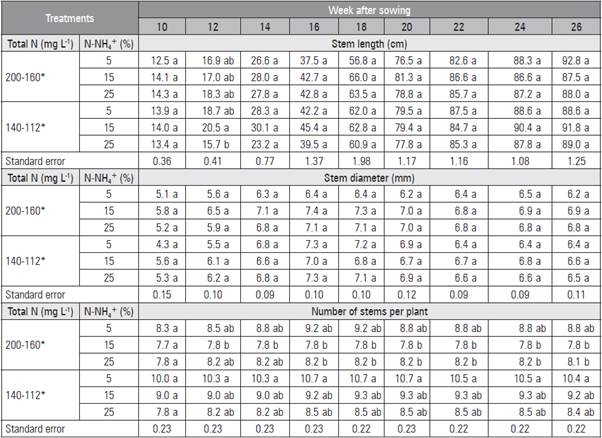
* The first concentration is the one used in the vegetative phase and the second in the productive phase.
Means followed with different letters indicate significant differences by Tukey test (P≤0.05).
This finding is consistent with the significant increases in productivity and quality variables reported by Kumar et al. (2016) with up to 150 mg L-1 of N in carnation plants cv. Red Corso. For NO3 -: NH4 + ratios, similar to that reported here, Khalaj et al. (2017) obtained the highest values for variables evaluated in Gerbera cvs. Stanza and Double Dutch with the lowest percentage of ammonium, i.e. the 80:20 ratio. On the other hand, Dufour and Guerin (2005) found improvements in development and yield in anthurium with increases in the NH4 +:NO3 - ratio, up to 0.37 of the total N.
This study confirmed that concentrations of 140112 mg L-1 of N in the vegetative and reproductive phases, respectively, are adequate for normal plant development and that the number of stems per plant is significantly lower in treatments with a higher concentration of total N, possibly because of a higher percentage of N-NH4.
Growth rates and indexes
Although the calculated rates and indexes LAI, LMR, SLA, RGR and NAR did not obtain significant statistical differences in any of the three samples in each of the evaluated treatments, the trends of these variables to elucidate the physiological behavior of the submitted plants are presented to the treatments (Fig. 1).
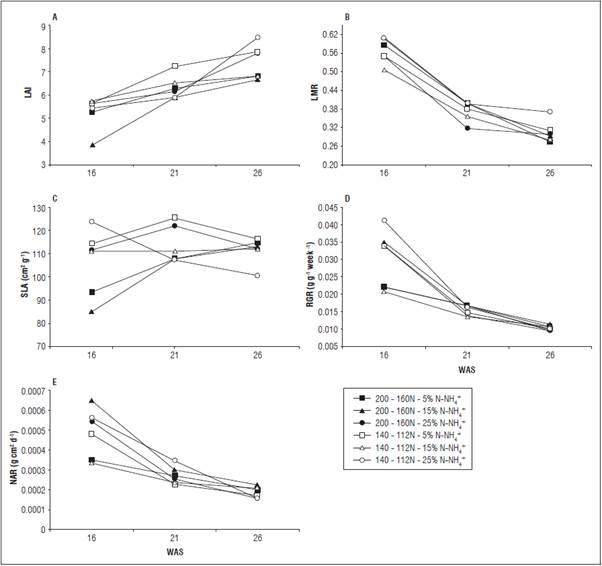
Figure 1 Behavior of standard carnation cv. Don Pedro planted in substrate and subjected to increases in the ammoniacal component of two fertigation formulas. (A) Leaf Area Index - LAI, (B) Leaf Mass Ratio - LMR, (C) Specific Leaf Area - SLA, (D) Relative Growth Rate - RGR, and (E) Net Assimilation Rate - NAR. WAS = weeks after sowing.
As expected, the LAI presented a pattern of gradual growth in all treatments, with a tendency for better yield in the treatments with a lower amount of total N, independent of the NH4 + concentration. When the foliar area intercepts the maximum photosynthetically active radiation, the optimal LAI is obtained (Hunt, 1978); Criollo and García (2009), for radish, and Carranza et al. (2009), for lettuce, obtained maximum LAI values of 3.4 and 6.8, respectively. When Cárdenas et al. (2006) took into account the leaf area of entire carnation plants cv. Nelson grown on substrate, they reported maximum LAI values between 4.4 and 4.8; meanwhile, for the same cv. at the second harvest peak, Baracaldo et al. (2010) reported maximum values between 7.5 and 8.7, similar to those obtained in the present study. Therefore, LAI values depend, among other factors, on the type of plant, variety, phenological stage of development and agronomic management. When plants use N better, the metabolism of carbon is optimized because these processes modulate each other (Maldonado et al., 2013), and leaf area affects the photosynthetic carbon gain, which is reflected in the growth rate of the plant (Taiz and Zeiger, 2002) through synthesis of new biomass.
In all treatments, there was a decrease in the LMR from the beginning of the trial, which indicated an inversion of photoassimilates in the formation of other plant structures. The highest value of this variable was seen in the treatments 200-160-15% N-NH4 + (commercial formula) and 140-112N-25% N-NH4 + at 16 WAS; although the latter treatment had a higher proportion of ammonium, the accumulation of dry leaf mass was not affected.
In the formulas with more nitrogen, a tendency for greater translocation of dry mass was observed, in comparison with the treatments using the most conservative formulas. When increased to 25% of N-NH4 + in the formula with high N, there was a decrease in the amount of biomass that is redirected to other structures of the plant. Therefore, it was inferred that, in the 200-160N-5% N-NH4 + treatment, the plants would direct more dry mass for the formation of flower buds, as observed at 26 WAS (Tab. 3). The marked decrease in the LMR from 16 to 21 WAS in all treatments coincided with the maximum AGR for the formation of flower buds (18 and 19 WAS). This relationship slowed down between 21 and 26 WAS when these structures reached their definitive development.
Table 3 Dry mass of carnation plants cv. Don Pedro grown on substrate, with decrease of the total N and increases in the component of N-NH4+ in the formula of fertigation.
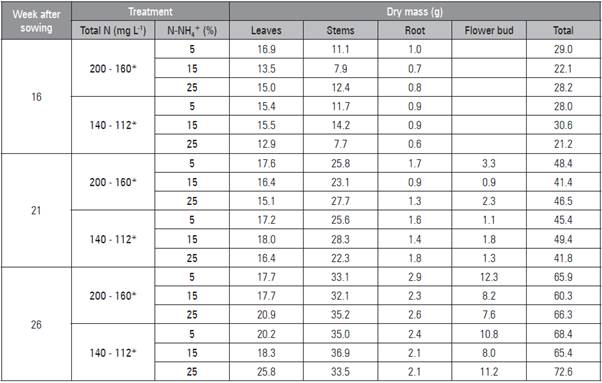
* The first concentration is the one used in the vegetative phase and the second in the productive phase.
Although in treatments 200-160N-5% N-NH4 + and 200-160N-15% N-NH4 +, the SLA started low at 16 WAS (Fig. 1C); treatments 200-160N-25% N-NH4+ and 140 -112N-5% N-NH4 + had the same response profile, that is, they had a greater leaf area in relation to their dry mass, becoming sources of carbohydrates for sink organs between 16 and 21 WAS. The other treatments, although they were sources of assimilates, exported them less efficiently: in the 140-112N-15% N-NH4 + treatment, what was synthesized was exported without affecting the SLA, and, in the 140-112N-25% N-NH4 +, less than what was synthesized was translocated, reducing the SLA and maintaining a good amount of the biomass it synthesized in the leaves (Tab. 3). A high SLA indicates greater foliar area with light leaves and, consequently, greater capacity to capture light and produce carbohydrates. An SLA increase response indicates a constant partitioning of carbohydrates to sinks with high demand. With the most conservative fertigation formulas for total N, the ammoniacal component played a preponderant role, where the highest percentage negatively affected the SLA, as seen in the 140-112N-25% N-NH4 + treatment (Fig. 1C).
For RGR, two response groups were observed (Fig. 1D): in the group of treatments with a higher RGR, 140-112N-25% N-NH4 + stood out, which means that it was the most efficient treatment in the accumulation of new biomass to the system. This was reflected in leaves with the lowest SLA towards 26 WAS (Fig. 1C). This was explained by a reduction in the leaf area and an increase in the biomass, as shown in Tab. 3, verifying that, in this treatment, the plants invested more dry mass in the leaves and flower buds at the expense of the stems and roots. In the second group, with a lower initial RGR (200-160N-5% N-NH4 + and 140-112N-15% N-NH4 +), regardless of the total N concentration, were not found the highest percentages of ammonium, which would stimulate the accumulation of new initial biomass. According to Grime and Hunt (1975), the highest RGR value was obtained in plants grown under conditions of greater fertility. In gerbera, an increase in the proportion of NH4 + in the nutrient solution resulted in larger fresh and dried masses in the shoots and roots, with higher values in the 80:20 (NO3 -:NH4 +) ratio (Khalaj et al., 2017).
For Baracaldo et al. (2018), a reduction of total nitrogen and an increase in the NH4 +: NO3 - ratio in the fertigation formula modified nutrient contents in carnation cv. Don Pedro plant tissue: with the lower content of total N, the contents of Cu and Zn were significantly increased; the increase in NH4 + significantly raised the contents of N and Zn and reduced Mg. The highest Mg content was observed at 16 and 21 WAS in treatments with the lowest percentage of NH4 + (5%). Thus, from the nutritional point of view, the better yield in the conservative treatments for total nitrogen was understandable, with a lower percentage of ammonium.
Similar to RGR, the same response groups, possibly associated with the percentage of ammonium (Fig. 1E), were evident for NAR. For this parameter, the highest initial NAR value was observed in treatment 200-160N-15% N-NH4 +. NAR represents the photosynthetic efficiency and decreases in the course of the development of the flowering stem, behavior that is associated with the leaf area existing in the first days after the pinch, when the leaves are more exposed to radiation and are more efficient at the assimilation of CO2. At the end of the cycle, similar values were seen in all treatments, with the smallest increases in total dry mass resulting from, among other factors, processes of foliar senescence, high planting density and plant architecture, which generate leaf shady, which causes a reduction in photosynthetic efficiency (Fig. 1E).
Productivity and quality
Taking into account the nitrogen factor, no statistically significant difference was found between the 200-160N and 140-112N treatments, with productivity averages of 83.5 and 87.9 stems/m2 of greenhouse area, respectively; it follows that the same level of productivity could be achieved with less total nitrogen in the formula. However, the increases in N doses used by Thakulla et al. (2018) in exotic carnation var. Chabaud had a positive effect on most of the parameters attributed to growth and flowering, with the exception of the maximum dose, which delayed the time to flowering. For this variable, the minimum time was obtained with 300 kg ha-1 of N, while the maximum plant height, the length of the flowering stem and the number of branches were obtained with a rate of 400 kg ha-1 of N.
On the other hand, there was a decrease in the percentage of stalks in the Select quality grade as the percentage of ammonium increased, with a consequent increase in the percentage of flowering stems in the Fancy quality grade (Fig. 2).
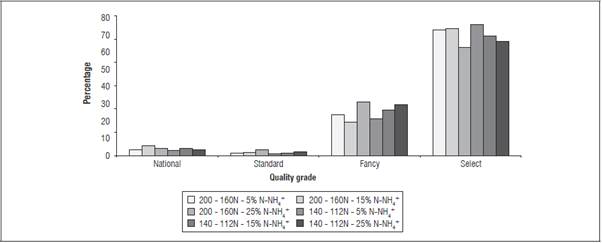
Figure 2 Quality of standard carnation flowering stems cv. Don Pedro planted in substrate subjected to different nitrogen fertilization treatments.
Although there would not be a statistical difference, productivity would increase to four more stems per m2 with a higher degree of quality and the economy in the cost of the fertilizer and in the environmental impact would result in higher profits for producers.
Achievements in productivity and quality based on particular NH4 +:NO3 - ratios were addressed by Tabatabaei et al. (2006) in strawberries, based on better calcium-based nutrition and increases in leaf area and photosynthesis rate, and better SPAD values and quantum yield of PSII (Fv/Fm) (Roosta, 2014), or, in tulips, with maximum concentrations of Ca and Mg, flower longevity, dry mass and optimal N, P, K (Abasi et al., 2016).
Nitrogen use efficiency - NUE
At 21 WAS, the plants of the 140-112 N treatment presented a significantly higher NUE value compared to the treatment with the highest N concentration, indicating that the gain of dry mass resulted from a more efficient use of N (Fig. 3). Dry mass production is closely related to NUE. In this experiment, no statistically significant differences were found in the dry mass values (Tab. 3), hence the plants fertilized with the lowest concentration of N had higher NUE values, in a manner consistent with that reported by Good et al. (2004) and Lupini et al. (2017).
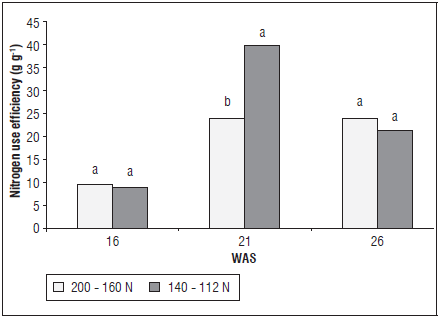
Figure 3 Efficiency in the use of nitrogen in standard carnation plants cv. Don Pedro planted in substrate under different nitrogen fertilization treatments. Means followed with different letters indicate significant differences by Tukey test (P≤0.05).
With the onset of the reproductive phase, according to Kant (2018), there is a parallel breakdown of proteins in the process of foliar senescence, and the released amino acids and other N compounds must be efficiently directed towards sink organs. This step is a critical component to improving NUE and thus avoiding wasted proteins and amino acids.
In oats with applications of 80, 100 and 120 kg ha-1 of N, it was found that NUE decreased significantly with increasing doses of N, with values of 38.3, 34.7 and 30.2 kg of grain/kg of N applied, respectively (Rahman et al., 2011). This coincides with that obtained in this study, where the higher concentrations of N (200 and 160 mg L-1) had a lower NUE than the lowest concentration. To achieve a greater NUE in carnation cv. Gaduina, a constant release of the N incorporated in the soil is required (Muthukrishnan et al., 2014).
CONCLUSIONS
In both fertigation formulas:
similar productivity and qualities were obtained, and the formula with less total N had better NUE, mitigating the negative environmental impact of this nutrient.
the ammoniacal component plays a preponderant role: the number of flowering stems per plant decreased as the ammonium component increased, similar to that observed with the percentage of flowering stems in the Select quality grade.
















